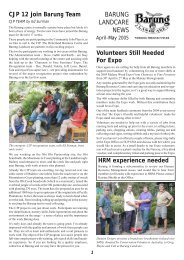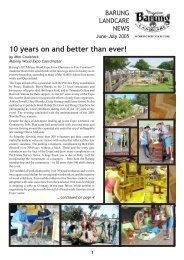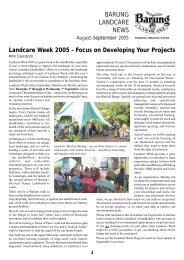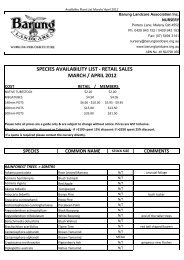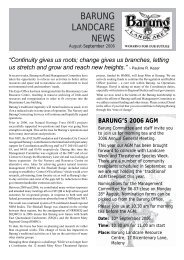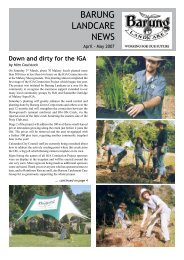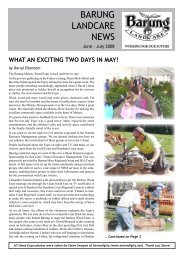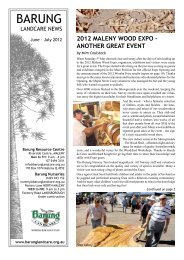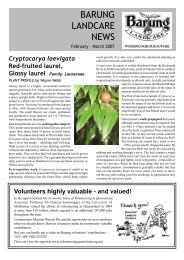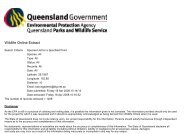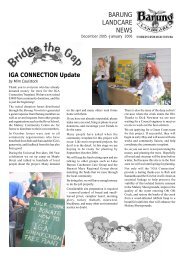Jun/Jul 2010 - Barung Landcare
Jun/Jul 2010 - Barung Landcare
Jun/Jul 2010 - Barung Landcare
Create successful ePaper yourself
Turn your PDF publications into a flip-book with our unique Google optimized e-Paper software.
Elaeocarpus grandis<br />
BLUE QUANDONG<br />
PLANT PROFILE by Dawn Worthington<br />
As the Latin name ‘grandis’ suggests, Blue Quandongs are large<br />
beautiful trees that can attain a height of up to 35 metres, usually<br />
emerging from the upper rainforest canopy. This species has an<br />
open spreading habit and the crown is characterised by almost<br />
horizontal branches on which the older leaves turn red before<br />
they drop. Another identifying feature is the trunk which can be<br />
up to 2 metres in diameter. The large buttressed roots at the base<br />
of the trunk looking somewhat ‘fig like’.<br />
Elaeocarpus grandis is often found along watercourses in subtropical,<br />
dry and littoral rainforest systems from northern NSW<br />
to the tip of Cape York, and also in the Northern Territory.<br />
This species is an important<br />
feature in revegetation<br />
work. The Blue Quandong<br />
is a somewhat hardy and<br />
quick-growing species so it<br />
can be used in initial plantings<br />
so long as there is no<br />
danger of frost at the site.<br />
Avoid planting this species<br />
on ridgetops where the tops<br />
Elaeocarpus grandis<br />
seedlings at the<br />
<strong>Barung</strong> Nursery.<br />
SPOTTED ANY QUOLLS?<br />
by Lin Fairlie<br />
Have you seen a quoll on or near your property? Or perhaps you<br />
might have seen evidence of quolls on your walks?<br />
Spotted Quolls are quite handsome, like a large cat with largish<br />
white well distributed spots. Around here they would frequent<br />
the mountain rainforests including sclerophyll forests. Quolls are<br />
carnivores and are probably keeping down the population of bush<br />
rats in your vicinity. Spotted Quolls were endemic to the upper<br />
Mary but due to their habit of raiding chook houses they were often<br />
shot on sight. Now they are rare and the Quoll Seekers network<br />
is interested in hearing if any quolls have been seen.<br />
The Quoll Seekers Network (supported by the Qld Wildlife<br />
Preservation Society) has produced three excellent brochures:<br />
‘Quolls in the Mary River headwaters’, ‘Building a quoll-proof<br />
poultry pen’ and the regular ‘Quoll Seekers Network News’.<br />
Quolls are an endangered species so for $10 a year you can adopt<br />
a quoll and receive an information pack. Donations are used in<br />
supporting habitat as well as in raising community awareness,<br />
carrying out survey work etc and identifying threats to habitat<br />
and how to address them.<br />
To report a quoll sighting or for more information go to:<br />
www.wildlife.org.au/projects/quolls/<br />
Please update your EMAIL ADDRESS<br />
on the <strong>Barung</strong> Membership Database<br />
Online at www.barunglandcare.org.au<br />
can be ‘blown out’ during extreme wind events. Blue Quandongs<br />
prefer moist, not wet, well-drained soils, meaning that it is dominant<br />
in alluvial flats and gullies.<br />
The foliage is simple, alternate, finely and regularly toothed<br />
and can be up to 15 cm in length, tapering to a rounded point at<br />
the tip. The leaves are glossy and dark in colour on the top and<br />
slightly paler beneath. Domatia are prominent and very distinct.<br />
The skirt-like flowers which occur at this time of year (autumn<br />
to winter) are white/light green to somewhat pinkish and very<br />
delicate, hanging in pendulous sprays.<br />
The distinctive fruit is a large drupe, iridescent blue in colour,<br />
being 2 to 4 cm in length. The fruits of our quandongs are a much<br />
favoured food source for many rainforest birds including the<br />
Green Catbird; Rose-Crowned, Superb and Wompoo Fruit-Doves;<br />
Top-Knot Pigeons; and Fig Birds. The fruit has a fleshy outer<br />
layer enclosing a hard wrinkled seed. The flesh of Elaeocarpus<br />
grandis can also be eaten raw as ‘bush tucker’ and the seed is used<br />
in jewellery and ornamental uses. I used quandong seeds from<br />
Central Australia to play ‘knuckles’ as a young child, gathering<br />
them from small trees in the desert country.<br />
The seed capsule is quite hard which may have an impact on<br />
germination rates. Fresh seed has erratic rates of germination,<br />
ranging from 6 to 10 months occasionally up to 24 months. You<br />
can hasten the germination of moist seeds by storing them in a<br />
plastic bag until roots appear. Some propagators scarify the seed,<br />
putting the seed in a cement mixer with rocks for example. At the<br />
<strong>Barung</strong> Nursery we prefer not to use this method at this time.<br />
The Blue Quandong is a majestic tree especially when planted<br />
in the correct location, so if you have the space and well-drained<br />
soils with moisture, this could possibly be the tree for you!<br />
Building a quoll-proof poultry pen<br />
By protecting your poultry from quolls you can also protect<br />
your poultry from other predators such as foxes, snakes,<br />
goannas, dogs, and birds such as raptors and crows. Here<br />
are some guidelines:<br />
• Use 1 inch bird wire or 1 cm budgie or mouse wire and<br />
have a netting roof over the poultry enclosure (quolls are<br />
excellent climbers).<br />
• A double thickness of wire around the base of your<br />
poultry yard is strongly recommended.<br />
• Bury the wire netting at least 15 cm below the ground<br />
(quolls are not good diggers, but goannas and foxes are).<br />
Perhaps incorporate some rocks around the base of the<br />
wire to further discourage digging.<br />
• Make sure there are no gaps around the base, door etc.<br />
• If building a moveable enclosure, incorporate an outwards<br />
directed skirt of wire around the bottom of the pen.<br />
• Secure your poultry each night as this is when most<br />
attacks occur.<br />
“86% of wildlife entangled on barbed wire<br />
fences are caught on the top strand...”<br />
Wildlife Friendly Fencing: ww.wildlifefriendlyfencing.com<br />
Dangers of monofilament netting on fruit trees:<br />
www.wildlifefriendlyfencing.com/WFF/Netting.html<br />
Newsletter:<br />
www.wildlifefriendlyfencing.com/WFF/Newsletter.html<br />
7



